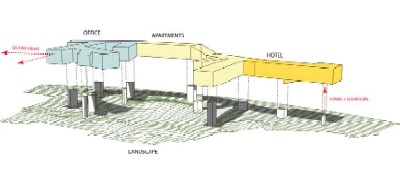Inquiring minds might be wondering whether or not we are headed for a Goldilocks landing or a recession so let's dig a bit into the numbers.
Release Highlights
- The deceleration in real GDP growth in the third quarter primarily reflected an acceleration in imports, a downturn in private inventory investment, and a larger decrease in residential fixed investment.
- Motor vehicle output contributed 0.72 percentage point to the third-quarter growth in real GDP after subtracting 0.31 percentage point from the second-quarter growth.
- The price index for gross domestic purchases, which measures prices paid by U.S. residents, increased 2.0 percent in the third quarter, compared with an increase of 4.0 percent in the second.
- Excluding food and energy prices, the price index for gross domestic purchases increased 1.9 percent in the third quarter, compared with 2.9 percent in the second.
- Durable goods increased 8.4 percent, in contrast to a decrease of 0.1 percent.
- Nondurable goods increased 1.6 percent, compared with an increase of 1.4 percent.
- Private businesses increased inventories $50.7 billion in the third quarter, following increases of $53.7 billion in the second quarter and $41.2 billion in the first.
- Personal saving -- disposable personal income less personal outlays -- was a negative $46.8 billion in the third quarter, compared with a negative $54.6 billion in the second. The personal saving rate -- saving as a percentage of disposable personal income -- increased from a negative 0.6 percent in the second quarter to a negative 0.5 percent in the third.
- Implicit price deflators (table 4) were 3.3 for Q1, 3.3 for Q2, and 1.8 for Q3.
- Motor vehicles and parts added .60 in Q1, �.04 in Q2, and .41 in Q3
- Furniture and household equipment added .65 in Q1, .10 in Q2, and .21 in Q3
- Motor vehicle output (release addenda) added .12 in Q1, �.31 in Q2, and .72 in Q3
AutoNation reported new-car sales fell by 7.6% in the third quarter.
The number of new cars sold by the nation's largest automotive retailer dipped 7.6 percent in the third quarter that ended Sept. 30 from a year ago. Yet that was less than the 11 percent fall in new-vehicle retail sales in the United States that CNW Marketing/Research has reported.Car and Driver reported GM's Third-Quarter Sales Slide 3 Percent.
AutoNation blamed the drop on higher interest rates, a softening economy and the generous discounts that boosted sales in the third quarter last year.
"There's no question the consumer has been knocked back on their heels," said AutoNation Chairman and Chief Executive Mike Jackson. "The economy is clearly in transition. We don't know if it's going to be a hard landing or a soft landing for the economy."
MSNBC is reporting Ford loses $5.8 billion in the third quarter.
The nation�s second biggest automaker said its loss widened to $5.8 billion in the third quarter, weighed down by the costs of its massive restructuring plan. Company officials also predicted things would get worse in the fourth quarter, as market share drops and Ford pays for further plant closures and restructuring costs.A Mirage, a Fluke, or Something Else?
Dearborn-based Ford�s turnaround plan aims to cut $5 billion in costs by the end of 2008 by slashing 10,000 white-collar workers and offering buyouts to all of its 75,000 unionized employees.
The loss including restructuring costs was Ford�s largest quarterly loss since the first quarter of 1992, when the company lost $6.7 billion due mainly to accounting changes.
Excluding charges, Ford would have lost $2 billion on its North American automotive operations in the latest quarter. It blamed its decline in market share, intense competition, a drop in U.S. and European sales and a market shift away from its high-profit trucks and sport utility vehicles.
A quick read of the above might cause the inquiring mind to conclude the .72% added to the GDP for motor vehicle output was a mirage related to the ending of discounts by GM as well as channel stuffing of dealers with cars that were simply not sold.
But is "mirage" even the right word?
Bloomberg is reporting U.S. Statistical Fluke Exaggerated Growth, Will Be Reversed.
An unexpected increase in auto production last quarter was a statistical fluke that will be reversed, making current U.S. economic growth even weaker, according to a former Commerce Department economist.Is "Fluke" the right word?
Last quarter's annualized 26 percent increase in auto production shocked Joe Carson, now director of economic research at AllianceBernstein LP in New York. Without the gain, the economy would have grown at an annual rate of 0.9 percent, not the 1.6 percent the Commerce Department reported today.
Stephen Stanley, chief economist at RBS Greenwich Capital in Greenwich, Connecticut, called the output numbers ``the most unbelievable detail'' in the GDP report.
The composition of growth last quarter, which included an unexpectedly large accumulation of inventories, also prompted other economists to reduce estimates for fourth-quarter growth. An increase in inventories overall suggests manufacturers may need to trim production this quarter.
Nouriel Roubini is asking Was Q3 GDP growth manipulated upwards because of the coming elections or is the US government clueless about measuring output?
This mismeasurement of motor vehicle production in Q3 is highly suspicious coming about ten days before the US mid-term elections. It is also highly suspicious as it is not clear how the Bureau of Economic Analysis (BEA) at the Department of Commerce could have made such a gross mistake when seeing an alleged 26% increase in auto production that was patently at odds with many facts. During Q3 all the major US automakers - Ford, GM, Chrysler - announced production cuts for both Q3 and Q4. So, how could the folks at BEA argue and estimate that production went up by a whopping 26%? These data also do not make any sense as the Federal Reserve Board data on automotive production in Q3 show a sharp fall in production of motor vehicles of 12% (see http://www.federalreserve.gov/releases/g17/Current/g17.pdf, Table 1).Whether manipulated or not, auto sales are extremely likely to become a future drag on GDP. Furniture and other durable goods numbers are also suspect given the slowdown in housing.
So how come the FRB data show a -12.0% sharp drop in production while the BEA estimates show an incredible 26% increase in production in Q3? This is altogether fishy. If one wants to give the benefit of the doubt to the usually non-partisan statisticians at BEA one would have to conclude that they were clueless about estimating motor vehicle production and they used a wrong price index to deflate the value of auto sales. How could they make such a gross mistake and believe in their estimate 26% growth figure - when all news headlines for months have been presenting the bad news about the plight of US automakers - is anyone's guess?
GDP Deflator
Let's assume for the moment that the auto numbers were accurate. It still took a mammoth decrease in the price deflator from 3.3 in both Q1 and Q2 to 1.8 in Q3, to achieve the anemic 1.6 growth that was reported. Without that downward move in the deflator, GDP would have been basically flat. To the extent that prices rose more than indicated by the deflator, third quarter GDP is overstated.
Inflation Measures
Kevin Depew on Minyanville offered this succinct viewpoint on the CPI and Personal Consumption Expenditures (PCE).
Core inflation is supposed to measure the underlying trend in inflation, but it's difficult to parse out in real time which "pieces" of inflation are fleeting or transient. The Fed has "tweaked" the Consumer Price Index measure many times over the past decade to try and get to an inflation measure that is more durable, less transitory.Of course there is no such thing as an 'average' or 'aggregate price' in the first place. The entire exercise of trying to measure fluctuations in a basket of goods and services is futile. The process is made even more difficult because the bureaucrats attempt to measure hedonics (quality improvements) when making their claims. I talked about this in Inflation: What the heck is it? and on Mises.Org in Inflation Monster Captured.
But until recently no one had tried to apply any of those "tweaks" to the Personal Consumption Expenditures, which is the Federal Reserve Board of Governors' preferred inflation gauge in the first place.
A paper from the Dallas Fed looks at the technique in question, called the "trimmed mean" technique, as applied to the PCE. An interesting comment on inflation measures contained in that article goes directly to the difficulty of measuring inflation in the first place, whether one looks at core or an overall measure. It's not simply a matter of standing back and looking at all the prices, averaging them up and printing a number.
"Rather, consumers pay for the services in the form of lower interest rates earned on deposits. Imputing prices for such services is an inexact science and it is not clear to what extent central banks should pay attention to the behavior of these imputed prices when reckoning the overall pace of inflation."
Imputed prices raises all sorts of questions. Some argue that the Fed deliberately understates inflation. Others argue that they are deliberately overstating inflation to fight deflation.
I don't believe they are deliberately doing anything except functioning as a group of bureaucrats making decisions within a bureaucratic framework. That in and of itself should be quite enough to ensure as much dysfunctionality as anyone could want.
The important point above is to not underestimate the massive amount of dysfunctionality created when basically useless numbers are essentially pulled right out of thin air by a bunch of government bureaucrats.
Home Sales
Here is a little "numbers gem" spotted by Calculated Risk.
Historically, the National Association of Realtors (NAR) used 11.43 as their Seasonal Adjustment for September. This year they used 11.73.
The NAR reported 6,180,000 SAAR.
Using 11.43 results in a SAAR of 6,020,000.
On that basis sales fell over 16% from 2005.
Here is the actual report: September Existing-Home Sales Ease, Setting State for Stable Market
For Alternate Headlines and additional information see Calculated Risk's posts NAR: Sales Down, Prices Down and NAR Adjustment.
Grossly Distorted Procedures
Previously I proposed changing the meaning of GDP from Gross Domestic Product to Grossly Distorted Procedures. If one discounts third quarter motor vehicle output, and subtracts various hedonics and imputations, GDP was easily negative for the third quarter (and perhaps substantially so). If one believes the published price deflators are off, GDP will look even worse.
I questioned GDP on Silicon Investor this past weekend and was astounded to receive the following reply:
If you want to make money you better believe theNot only was I stunned to find someone that actually believes all those numbers, I was equally stunned to find a person that actually thinks you have to believe those numbers to make money. It is of course the reaction to the numbers that matters. Whether or not anyone actually believes them is irrelevant.
GDP
CPI
Unemployment Numbers
Because what you personally think is "real" is irrelevant.
In the meantime I notice that almost no one is talking about the yield curve, the one set of numbers that someone can and should believe. The Yield curve is what it is, and it is quite inverted, signaling a recession. Forget Goldilocks, the next recession will be an extremely hard affair, led by a falloff in consumer spending, rising unemployment, and a continued slowdown in housing.
Mike Shedlock / Mish
http://globaleconomicanalysis.blogspot.com/




















